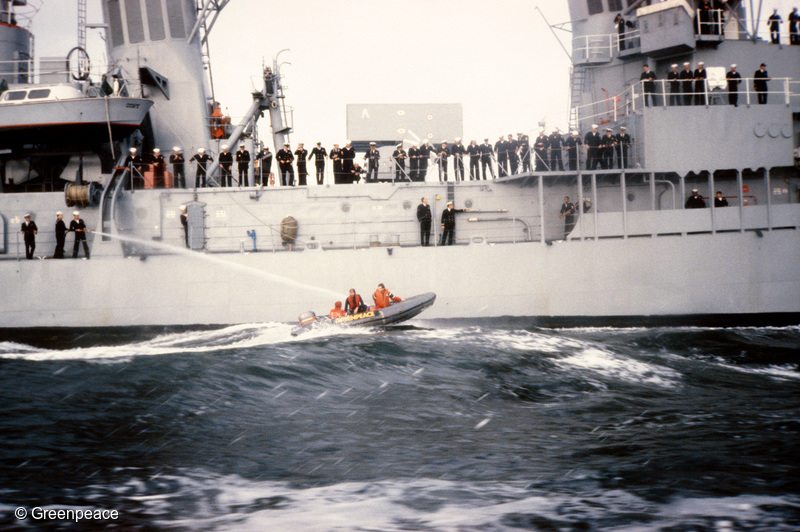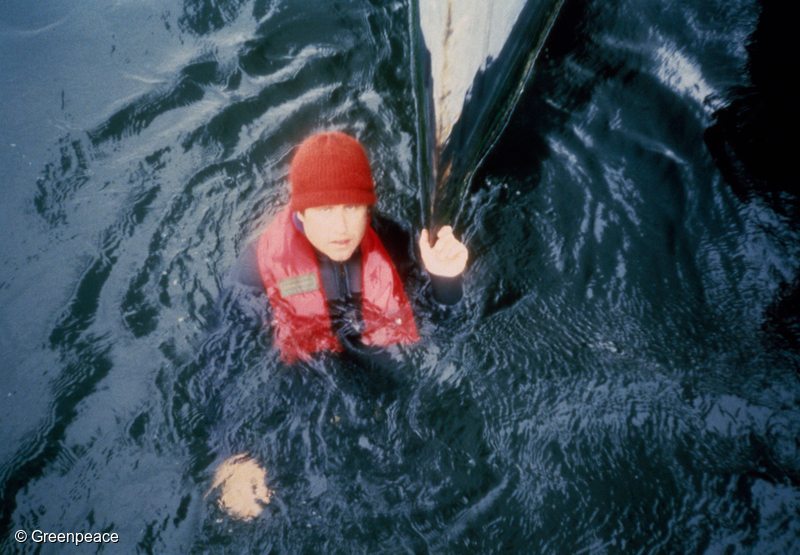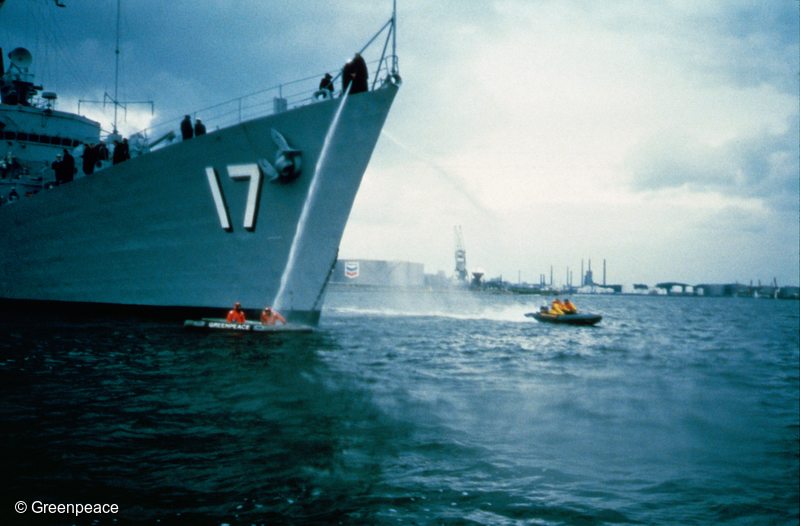
A Greenpeace inflatable flanks the U.S. Navy destroyer USS Conyngham.
“Rule number one when jumping in front of a speeding destroyer: keep all of your body parts on one side of the bow.”
Peter Willcox writing with Ronald Weiss in the new book “Greenpeace Captain”
Harald Zindler is Greenpeace’s mad genius. Some of us call him the Actions Guru because he’s the man who has dreamed up the majority of Greenpeace’s most famous exploits. He’s also an inventor of sorts, creating some of the wildest action innovations we’ve ever used.
Harald and I shared a desk in Hamburg and sat right across from each other. I took great pleasure in listening in on many of his conversations, and he taught me a lot about problem solving and thinking things through.
One day I heard Harald describing an action he was planning; we were going to try to stop a U.S. nuclear-missile-equipped destroyer from entering nuclear-free Denmark. Two months before, the Danish government had declared the country “nuclear-free” and banned nuclear weapons and nuclear-propelled ships from its waters. The U.S. Navy was planning to test that ban with the Adams-class guided missile destroyer USS Conyngham.
To save face the Danish government had formally asked the United States if the Conyngham was going to be carrying nukes during her visit. The U.S. Navy’s response was essentially ‘we can neither confirm nor deny,’ and the Danish government then decided to assume they would not.
Still, everyone was pretty clear on the fact that the ship would be carrying nukes since the navy had gone to great expense to equip the ship to do so. Furthermore, immediately prior to her departure, the destroyer and her entire crew had been put through a comprehensive nuclear weapons certification process. The ship was scheduled, ironically, to arrive on July 4 — American Independence Day.
After overhearing the plans for the reception that Harald was organizing for the destroyer, I begged him to let me come and join in the fun.
To stop the destroyer, we were going to set divers in the water across the harbor channel that the Conyngham was going to be steaming through. International navigational rules state that if there is a diver with an international diving flag in the water, all vessels must stay well away from the area and slow way down. In theory, that meant that the destroyer was supposed to stop.
The divers were going to be in the water wearing Gumby suits, a common nickname for survival suits. While the suits will keep you alive for a long time in the water, you can’t swim, dive, or generally move around much. You’re a sitting Day-Glo duck. We expected that the destroyer would simply move through the divers like a skier on a slalom course, but it’d make for some good pictures and possibly slow the ship down enough that we could put plan B into effect.
Plan B was me.

Peter Willcox at the “knife-edge” (the bow) of the destroyer, with his personal flotation device inflated to prevent him from being sucked under the warship and into its propellers.
As plan B, I would be positioned directly in front of the moving destroyer and attempt to latch on to the bow of the ship. Jan Madsen, the chief engineer on our 110-foot trawler Moby Dick, fashioned a piece of hook-shaped rebar with a handle on it that I could use to grab on to the Conyngham’s bow.
After experimenting with a few different techniques, I remembered something stupid I used to do as an adolescent kid growing up in Norwalk: I would grab a water-ski towline, lie in the water on my back, and get pulled along — headfirst — by the ski boat, skipping along the surface like a flapping fish getting reeled into a boat. I demonstrated the technique for Harald and he was delighted with it. For added maneuverability, I would wear a scuba suit and swim fins instead of the Gumby getup.
“It’s a good day to die.”
That line from the movie “Little Big Man” kept running through my head as I bobbed in the channel waiting for the Conyngham to show herself. There were six of us in the water — five Gumbies and me. Each of us had large, orange inflatable fenders with diver flags tied to sticks.
The Greenpeace inflatables and support boats had pulled well away from the line of divers. The thinking was that if the destroyer saw boats near us, it might convince them we would be moved out of the way. Without the boats nearby, they would see we were determined to stay in their path. Soon, in the gathering light, we were able to make out the signal masts, antennae, and then the bridge of the Conyngham coming up over the horizon. She was quickly getting bigger and bigger. Clearly she had a good head of steam; she was moving fast. Even as she closed on us, we couldn’t hear her bow wave or engines at all.
It was quiet.

The USS Conyngham in Danish waters.
Five blasts of the Conyngham’s horn ripped through the morning air, the international signal for ‘you are in imminent danger, get out of the way.’ Well, we weren’t going anywhere. A few seconds later it looked to me like she was changing course. She was. She blew right through the narrow gap between me and Katrin. As the destroyer passed us I could hear the bow wave, but there was still no sound from her engines or the giant bronze propellers churning just 20 feet below us. The inflatables quickly swooped in, picked us all up, and charged ahead of the Conyngham so we could try again.
This time, we were going to drop the divers off directly in front of the ship.
Harald positioned the jet boat about 100 yards in front of the ship and yelled, “Jump!” We were now close enough that I could hear the bow wave. I didn’t hesitate, but when I looked up the ship was right there. Rule number one when jumping in front of a speeding destroyer: keep all of your body parts on one side of the bow! This is important. If you get a lower leg — or, worse, a femur — across the bow, you’ll be lucky if it’s just broken.
I didn’t have a chance to get the hook on her.
On the next attempt I let the bow come by so close I could touch it. The bow wave slapped me in the head as she went by, my hand dragging along the gray steel hull of the ship.
Once the bow wave passed, it was so quiet that I could hear one of the sailors high above me shout: “Watch out for the propellers!” I tried yelling back “Do you know you’re breaking Danish law?” but by then I was already past her stern. Harald came back to pick me up, and that was one of my all-time favorite Greenpeace moments: Harald, looking very concerned, telling me in a stern Germanic voice, “Don’t get so close to the bow! You really scared me!”
As the Conyngham approached the inner harbor, her speed dropped to roughly six knots and I was finally able to get my hook on her bow.
I had just hooked on to the bow of a 4,500-ton “whale” and was riding along quite happily until all of the destroyer’s fire hoses trained on me. Most ships use fire hoses that are pressurized at 100 pounds per square inch (psi). The navy, being the navy, uses 200 psi. That’s a lot of pressure. The pressure of all those hoses forced me under her bow wave and I somehow got unhooked.
One of the boats quickly picked me up again and brought me back to the bow, where I was able to hook on again. This time, to counteract the force of the fire hoses, I inflated my life vest to keep me above the water so I could hang on. This also reduced the risk of being chummed by the propellers.
Finally the Conyngham came to a stop, but I didn’t know why.
“Come along now, son. You’ve had your fun. Why don’t you swim over and get in our boat before you get hurt?” said a Danish policeman who had just arrived on the scene in a police boat.
Read the rest in Greenpeace Captain: My Adventures in Protecting the Future of Our Planet, by Peter Willcox with Ronald Weiss. Excerpted with permission. Available from Thomas Dunne Books. Copyright © 2016.


